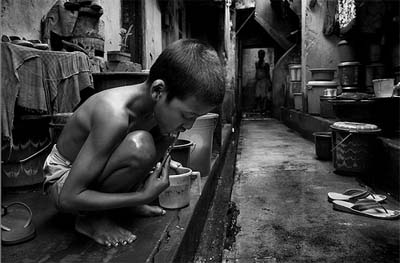However, public policy towards poverty alleviation, of which RPW are one special case, is often subject to the phenomenon of ‘capture’ whereby the benefits of programs, ostensibly meant to target the poor, are garnered by non-poor. An important question in this context is the following. If the non-poor manage to garner the bulk of the benefits from an anti-poverty program, do they get satiated over time, i.e., do the poor become better aware of the potential advantages of RPW and seek to overcome the barriers to participation?
In the ASARC Working Paper [pdf] (No. 2009/16) ‘Timing of Capture of Anti-poverty Programs: Rural Public Works and Food for Work Programs in Rural India’ Raghbendra Jha, Sambit Bhattacharyya and Raghav Gaiha compute average odds of participation (AOP) given by the ratio of the quintile-specific average participation rate to the overall average for various quintiles of per capita expenditure for Scheduled Castes (SC), Scheduled Tribes (ST), Landowners and the rural population as a whole. They also compute marginal odds of participation (MOP) defined as the increment to participation in that program for various quintiles of per capita household expenditure. The computations are for RPW in 1993-94 and Food for Work (FFW) programs in 2004-05 using large scale National Sample Survey Household Survey for the 50th and 61st rounds respectively. Differences between AOP and MOP reflect differences in the incidence of infra-marginal spending. If the MOP is greater than the AOP for the poorest quintile within a particular social group, then the population in the poorest quintile will benefit more than the others from an increase in overall spending, indicating lower capture from the extra spending.
In 1993-94 among SC AOP were highest for the richest quintile in this group, indicating substantial program capture. Capture was also high for ST and the overall population. Among landowners AOP were highest for the 2nd and 4thquintiles.
In 2004-05 for the SC, there is evidence of capture as the AOPs are the highest for the 3rd and 4th quintiles. In contrast, the situation improved for the ST with the poorest quintile reporting the highest AOP and falling steadily across expenditure quintiles. Landowners had a similar experience.
If the MOP for a group is higher than the AOP then its chances of getting into the program are higher. In 1993-94 the RPW was reasonably well targeted toward the poorest quintile among the ST and the landowners but not among the SC and the rural population as a whole. The second poorest quintile among every section of the population had MOP higher than AOP indicating that this expenditure class was better targeted. Among the third poorest expenditure class the MOP was lower than the AOP for all caste and asset groupings except ST. Therefore only the ST experience program capture by the third quintile. MOP was uniformly higher than AOP across all caste and asset groups in the fourth expenditure class, indicating substantial capture.
AOP and MOP rankings for 2004-05 were broadly similar except that in the latter time period in the case of SC MOP is lower than AOP for the second quintile. AOP is higher than MOP for the third and fourth quintiles indicating better targeting but MOP is higher for the richest quintile indicating a substantial deterioration in targeting. In 2004-05, only the richest quintile among the SC had higher MOP than AOP indicating substantial capture. In contrast, targeting improved amongst the ST and the landowners.
Formal econometric testing reveals that in the case of the SC capture has increased for the fourth quintile, for the fourth quintile of the ST and for the fourth quintile of landowners over time. Thus, in these cases, there has been a clear deterioration of targeting. Against this, however, capture by the richest among the ST and the richest among the landowners dropped. On balance then, capture worsened over the time period 1993-94 to 2004-05.
Our results point to the necessity of income based targeting of anti-poverty programs. Social group based targeting seems unable to prevent the growth of program capture by high income elites within these groups.
This article originally appeared here in the South Asia Masala.

